Common Plant Pests
Insects are a type of plant pests. They cause damage to plants from their feeding or during the course of completing their life cycles on the plants. Garden sanitation and good agricultural practices can prevent or reduce the spread of infestation.
Insect pests can be divided in to 3 main groups :
- Sucking insects
- Chewing insects
- Boring, mining & soil insects
Sucking & Piercing Insects
The mouthparts of sucking insects are developed for piercing and sucking. These pests damage plants by inserting their mouthparts into plant tissue and removing juices.
Examples :These include fruit piercing moths, sucking bugs, thrips, scales, mealybugs, aphids and mites.
Symptoms: Damage symptoms include spots or lesions, scarring, bronzing or silvering on plant tissue.Plants may appear stunted or develop yellow or brown leaves. Sap sucking insects excrete honeydew which promotes the growth of black sooty mould. The following are some examples of sucking insects:
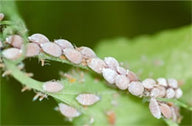
Aphids : These winged or wingless, tiny insects flock in great numbers on tender shoots and flower buds and suck the sap. They flock and breed in such profusion that they cover the entire stems and flower buds. They are more common in winters. Aphids attack most cultivated plants. Apart from causing the damage by sucking the sap, they are also capable of infecting the plants with viral, bacterial and fungal diseases.
 Scales : Brownish irregular scaly growth on branches of hibiscus plants are actually colonies of brown scale insects. These are soft bodied insects with brown or blackish colour, having spine-like outgrowth on their bodies. Hard scales, resembling mini shields, cover entire stems of rose plants. All scale insects are capable of movement in their juvenile stage only. The hard scales insects, as they settle on plants to suck the sap, start secreting a waxy substance. This Wax covers their bodies entirely, thus making them immobile and impregnable from contact type of insecticides.
Scales : Brownish irregular scaly growth on branches of hibiscus plants are actually colonies of brown scale insects. These are soft bodied insects with brown or blackish colour, having spine-like outgrowth on their bodies. Hard scales, resembling mini shields, cover entire stems of rose plants. All scale insects are capable of movement in their juvenile stage only. The hard scales insects, as they settle on plants to suck the sap, start secreting a waxy substance. This Wax covers their bodies entirely, thus making them immobile and impregnable from contact type of insecticides.
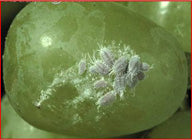 Mealy Bugs : Found in warmer growing climates, mealybugs are soft-bodied, wingless insects that often appear as white cottony masses on the leaves, stems and fruit of plants. They feed by inserting long sucking mouthparts, called stylets, into plants and drawing sap out of the tissue. Damage is not often significant at low pest levels. However, at higher numbers they can cause leaf yellowing and curling as the plant weakens. Feeding is usually accompanied by honeydew, which makes the plant sticky and encourages the growth of sooty moulds. Mealybugs are a common greenhouse pest that affect ornamentals, houseplants, avocados and fruits.Adults (1/10 — 1/4 inch long) are soft, oval distinctly segmented insects that are usually covered with a white or grey mealy wax. Small nymphs, called crawlers, are light yellow and free of wax. They are active early on, but move little once a suitable feeding site is found.
Mealy Bugs : Found in warmer growing climates, mealybugs are soft-bodied, wingless insects that often appear as white cottony masses on the leaves, stems and fruit of plants. They feed by inserting long sucking mouthparts, called stylets, into plants and drawing sap out of the tissue. Damage is not often significant at low pest levels. However, at higher numbers they can cause leaf yellowing and curling as the plant weakens. Feeding is usually accompanied by honeydew, which makes the plant sticky and encourages the growth of sooty moulds. Mealybugs are a common greenhouse pest that affect ornamentals, houseplants, avocados and fruits.Adults (1/10 — 1/4 inch long) are soft, oval distinctly segmented insects that are usually covered with a white or grey mealy wax. Small nymphs, called crawlers, are light yellow and free of wax. They are active early on, but move little once a suitable feeding site is found.
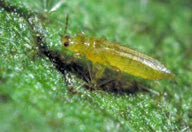 Thrips : The thrips are so tiny that they cannot be seen easily. They are winged and are capable of flight. Thrips cause immense damage to tender shoots and flower buds. Thrips have saw-like mouth parts with which they rasp the parts of plant and suck the juice. The affected parts look as if they are burnt. These insect are more common in hot summer days. As the damage caused by them resembles sunburns, people unaware of the presence of these insects, normally confuse the damage to be of sunburn.
Thrips : The thrips are so tiny that they cannot be seen easily. They are winged and are capable of flight. Thrips cause immense damage to tender shoots and flower buds. Thrips have saw-like mouth parts with which they rasp the parts of plant and suck the juice. The affected parts look as if they are burnt. These insect are more common in hot summer days. As the damage caused by them resembles sunburns, people unaware of the presence of these insects, normally confuse the damage to be of sunburn.
 Whiteflies : Common on houseplants and in greenhouses, the whitefly (Trialeurodes vaporariorum) is a sap-sucking insect that is often found in thick crowds on the undersides of leaves. When infested plants are disturbed, great clouds of the winged adults fly into the air. Both nymphs and adults damage plants by sucking the juices from new growth causing stunted growth, leaf yellowing and reduced yields. Plants become weak and susceptible to disease. Like aphids, whiteflies secrete honeydew, so leaves maybe sticky or covered with a black sooty mold. They are also responsible for transmitting several plant viruses. Host plants include more than 250 ornamental and vegetable plants. Citrus, squash, poinsettia, potato, cucumber, grape, tomato and hibiscus are commonly infested. Adults (1/16 inch long) are moth-like insects with powdery white wings and short antenna. They are easily recognized and often found near the tops of plants or on stem ends. Wingless nymphs are flattened, oval and almost scale-like in appearance. After the first instar, or crawler stage, they settle down and attach themselves to the underside of leaves and begin feeding.
Whiteflies : Common on houseplants and in greenhouses, the whitefly (Trialeurodes vaporariorum) is a sap-sucking insect that is often found in thick crowds on the undersides of leaves. When infested plants are disturbed, great clouds of the winged adults fly into the air. Both nymphs and adults damage plants by sucking the juices from new growth causing stunted growth, leaf yellowing and reduced yields. Plants become weak and susceptible to disease. Like aphids, whiteflies secrete honeydew, so leaves maybe sticky or covered with a black sooty mold. They are also responsible for transmitting several plant viruses. Host plants include more than 250 ornamental and vegetable plants. Citrus, squash, poinsettia, potato, cucumber, grape, tomato and hibiscus are commonly infested. Adults (1/16 inch long) are moth-like insects with powdery white wings and short antenna. They are easily recognized and often found near the tops of plants or on stem ends. Wingless nymphs are flattened, oval and almost scale-like in appearance. After the first instar, or crawler stage, they settle down and attach themselves to the underside of leaves and begin feeding.
 Leafhoppers : are small, green, wedge-shaped insects that attack many garden, forage and fruit crops. These tiny, winged insects are common in monsoon. Very often, attracted by lights, they come in houses at night. They are about the size of a wheat grain and the colours vary from green to brown They suck out plant juices causing yellowing, leaf-curling and stunting. They also transmit several disease organisms, especially associated with yellows.
Leafhoppers : are small, green, wedge-shaped insects that attack many garden, forage and fruit crops. These tiny, winged insects are common in monsoon. Very often, attracted by lights, they come in houses at night. They are about the size of a wheat grain and the colours vary from green to brown They suck out plant juices causing yellowing, leaf-curling and stunting. They also transmit several disease organisms, especially associated with yellows.
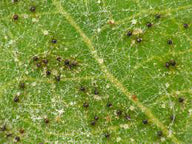 Spider mites: Spider mites are closely related to ticks and chiggers. They suck out juices from leaves and stems, causing plants to become deformed or have a bronze or yellow appearance. Hot and dry weather favors their development. Heavy infestations can cause leaf and flower bud drop and death of the plant.
Spider mites: Spider mites are closely related to ticks and chiggers. They suck out juices from leaves and stems, causing plants to become deformed or have a bronze or yellow appearance. Hot and dry weather favors their development. Heavy infestations can cause leaf and flower bud drop and death of the plant.
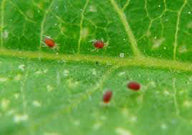 Red Mites : Mites are not insects. Mites are tiny spiders, red or brown in colour. They attack most plants. Their presence is indicated by dusty formations on the affected leaves. This is due to the dust, which settles on the webs spun by these tiny creatures. The affected leaves also show numerous colourless spots. This is due to constant sucking of plant juices.
Red Mites : Mites are not insects. Mites are tiny spiders, red or brown in colour. They attack most plants. Their presence is indicated by dusty formations on the affected leaves. This is due to the dust, which settles on the webs spun by these tiny creatures. The affected leaves also show numerous colourless spots. This is due to constant sucking of plant juices.
 Leaf-Cutting Bee: This is a type of a bee and is comparatively harmless. This bee cuts neat, circular or oval pieces of leaves only along the leaf edge. The pieces so cut are rolled to form a nest to lay the eggs. The leaf-cutting bee does not chew plant parts, neither does it suck sap.
Leaf-Cutting Bee: This is a type of a bee and is comparatively harmless. This bee cuts neat, circular or oval pieces of leaves only along the leaf edge. The pieces so cut are rolled to form a nest to lay the eggs. The leaf-cutting bee does not chew plant parts, neither does it suck sap.
Chewing Insects
Perhaps the most widely recognized type of insect damage to plants is chewing insect damage. Chewing damage is caused by insects with mouth parts consisting of two opposing mandibles, or jaws.
Examples: Chewing insects include caterpillars, grasshoppers, beetles and termites.
Symptoms: If plant damage includes missing parts of leaves, stems or entire plants demolished, you probably have a chewing insect pest.
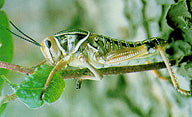 Grasshoppers : Camouflage easily on plants due to their green or brownish colours. These insects cut irregular cuts and punctures on leaves. Tender shoots too are eaten. Their droppings are like tiny pieces of charcoal. As they hop from plant to plant, grasshoppers may be or may not be present on the damaged plant.
Grasshoppers : Camouflage easily on plants due to their green or brownish colours. These insects cut irregular cuts and punctures on leaves. Tender shoots too are eaten. Their droppings are like tiny pieces of charcoal. As they hop from plant to plant, grasshoppers may be or may not be present on the damaged plant.
 Caterpillar : It is a larva of a moth which lays its white eggs in clusters, usually on the underside of leaves. The tiny, hairy caterpillars in a flock start scraping leaves. This makes the affected leaves look translucent. As they grow, they start nibbling the leaves, which get cut irregularly. Tender shoots, flower buds too are affected. The tiny caterpillars, which hatch out of the eggs, resemble droppings of sparrows in colour and shape. Mature larva is upto 35 mm in length. As the caterpillar grows bigger, it acquires green colour and then easily camouflages amongst the foliage.
Caterpillar : It is a larva of a moth which lays its white eggs in clusters, usually on the underside of leaves. The tiny, hairy caterpillars in a flock start scraping leaves. This makes the affected leaves look translucent. As they grow, they start nibbling the leaves, which get cut irregularly. Tender shoots, flower buds too are affected. The tiny caterpillars, which hatch out of the eggs, resemble droppings of sparrows in colour and shape. Mature larva is upto 35 mm in length. As the caterpillar grows bigger, it acquires green colour and then easily camouflages amongst the foliage.
 Beetle : The beetle causes irregular cuts and punctures on leaves. This insect is active in rainy season. The beetle is a nocturnal creature and causes the damage only at nighttime. During the day they hide in the soil.
Beetle : The beetle causes irregular cuts and punctures on leaves. This insect is active in rainy season. The beetle is a nocturnal creature and causes the damage only at nighttime. During the day they hide in the soil.
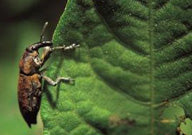 Weevil : The weevil is a type of snout beetle that is about 1/3 inch long. Weevils are gray-brown in color and feature a light "V" shape on their wings. Despite having wings, they do not fly and can live for up to two years. The larvae of these insects are leg-free and green and reach the same lengths as adult vegetable weevils. Weevil eggs are a whitish color that turns black before the insects hatch. Weevil larvae and weevil adults eat the foliage as well as the roots and buds of vegetable crops, including cabbages, carrots, beets, onions, radishes, potatoes, tomatoes and spinach. The leaves of the plant will be irregular, as though someone has been taking bites out of the edges. This damage will appear in the night, as root weevils come out to feed at night.
Weevil : The weevil is a type of snout beetle that is about 1/3 inch long. Weevils are gray-brown in color and feature a light "V" shape on their wings. Despite having wings, they do not fly and can live for up to two years. The larvae of these insects are leg-free and green and reach the same lengths as adult vegetable weevils. Weevil eggs are a whitish color that turns black before the insects hatch. Weevil larvae and weevil adults eat the foliage as well as the roots and buds of vegetable crops, including cabbages, carrots, beets, onions, radishes, potatoes, tomatoes and spinach. The leaves of the plant will be irregular, as though someone has been taking bites out of the edges. This damage will appear in the night, as root weevils come out to feed at night.
Boring & Mining Insects


















